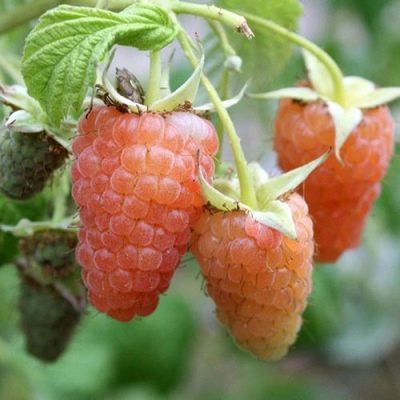
- Repairability: Yes
- Berry color: deep golden orange
- Taste: sweet
- Ripening period: early
- Berry weight, g: 8
- Frost resistance: winter hardy, up to -30 ° С
- Appointment: cook preserves and jams, compotes and jelly, prepare juices
- Fruiting period: June July
- Description of the bush: slightly spreading
- Bush height, cm: up to 230
Raspberry varieties with golden hues are not very common among gardeners and on industrial plantations. But, in addition to amazing sweetness and decorativeness, they have an important advantage: they do not cause allergic reactions. One of the best in terms of productivity and taste is the Orange (Yellow) giant variety.
Breeding history of the variety
The author of the variety was an outstanding Soviet and Russian breeder, Doctor of Agricultural Sciences Viktor Valerianovich Kichina. From 1976 to the early 2000s, at the Moscow Institute of Horticulture (VSTISP), he and his team developed more than 25 large-fruited varieties and elite forms of raspberries. In 1979, the Orange (Yellow) giant was obtained by crossing the Ivanovskaya and Maroseyka raspberry varieties. After lengthy research at experimental stations in 1991, the novelty entered the State Register and was presented for reproduction.
Description of the variety
The repairing high-yielding variety Orange Giant is distinguished by moderate winter hardiness and resistance to major diseases and pests. This is one of the largest-fruited varieties of Soviet selection. It stands out for its unusual golden-orange berry color and high sugar content.
Ripening terms
The variety belongs to early or medium early: berries ripen in late June - early July. Fruiting is extended, occurs on the shoots of the first and second years, lasts until the end of August, and in the southern regions until the first decade of September.
Growing regions
The most suitable territories for the variety are the center and south of the Non-Black Earth Region. The orange giant is doing well in the Moscow region. In areas north of Moscow, in the Urals, in Siberia, in the Far East, there is a certain risk for planting this variety.
Yield
On slightly spreading, medium-sized (150-230 cm) bushes with powerful shoots and numerous small thorns, an abundance of inflorescences is formed. Large white flowers self-pollinate, fruit setting occurs practically without loss. The industrial harvest is declared at the level of 30 kg / ha, from a bush per season you can get up to 9 kg.
Berries and their taste
Amber-orange large berries (weight about 8 g, length up to 4 cm) of elongated conical or slightly round shape have a sugar dessert taste with honey notes, practically without acid.
The fruits of this variety are best eaten fresh or used to make jellies and jams. It is better not to use them for freezing. One of the disadvantages is low transportability: the berries are not dense enough for long transportation and storage.

Growing features
The agricultural technology of the variety is similar to the generally accepted care for raspberries, but there are some peculiarities.
It is necessary to plant bushes at a distance of 1-1.5 m and thin out regularly, because the Orange Giant forms dense growth. It is recommended to dig in slate or iron sheets in order to create a barrier around the bush from "spreading" root shoots.
The variety does not like shading.
Coolness and dampness negatively affect the taste of the berries, and the lack of watering in the heat affects their size.
Site selection and soil preparation
The landing site is chosen level, sunny and protected from the wind. Rows of seedlings are arranged from north to south.
The best choice is loam or sandy loam soil. Before the autumn planting, the site is dug up, manure and superphosphate are added. Soil acid is reduced by adding lime. The roots of the seedlings should be deepened by no more than 30 cm.





Frost resistance and preparation for winter
The orange giant is a winter-hardy plant that can withstand frosts down to –30 ° С. To protect it from damaging factors (desiccation, damping, formation of an ice crust) in areas with lower temperatures, shoots should be bent down, and a covering material or spruce branches should be used. Before that, you need to prune, dig up the soil, add phosphorus and potassium fertilizers and mulch.
If the raspberry plant is in an open place, it is necessary to organize a wind barrier around the perimeter: a low fence with sheet material stuffed on it.

Diseases and pests
The variety turned out to be resistant to major diseases, primarily fungal. Due to the presence of the A1 gene, it is immune to the Amphorophora aphid. Breeders cannot get complete tolerance to root rot, so the main methods of dealing with it are: light soils, mulching, regular sanitary pruning and complete removal of diseased bushes with soil sanitation.
From pests (raspberry flies and beetles), in addition to chemical spraying, you can use the attraction of natural enemies, create favorable conditions for birds in the garden, and use herbal preparations.

Unfortunately, raspberries, like other plants, do not bypass various diseases and pests.Only armed with the knowledge and the necessary means for this, you can cope with such troubles. To help the plant, it is very important to be able to recognize the disease in time and begin timely treatment.
Reproduction
It is easy to propagate the variety from numerous root shoots: carefully with a lump of soil, future seedlings are separated from the mother bush and transferred to a new place.








































































